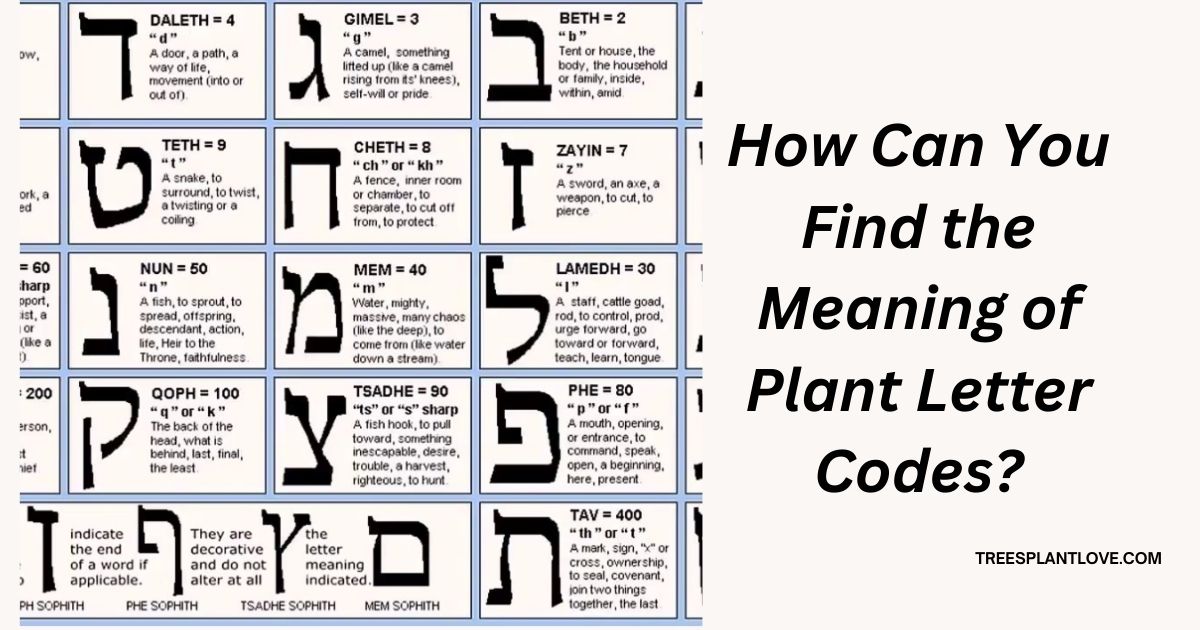
How Can You Find the Meaning of Plant Letter Codes? Complete Guide & Lookup Tools
How Can You Find the Meaning of Plant Letter Codes?: In the world of botany, agriculture, and horticulture, plant identification is crucial for understanding species, growth habits, and the overall management of plant life. One of the methods used to classify and catalog plants is through the use of plant letter codes.
These codes are shorthand representations that correspond to specific traits, origins, or classifications of plants. But how can you decipher the meaning of these codes? Let’s explore how you can effectively find and understand the meanings of plant letter codes.
What Are Plant Letter Codes?
Plant letter codes are alphanumeric strings, usually consisting of a combination of letters and sometimes numbers, which are assigned to plants for categorization purposes. These codes might be used to denote various aspects of a plant, such as its species, family, or growth characteristics. For example, in agriculture, certain codes may refer to specific cultivars of crops, while in botanical databases, they can represent taxonomic groups or conservation statuses.
How to Find the Meaning of Plant Letter Codes
- Consult Online Databases and Repositories
One of the most reliable and accessible ways to decode plant letter codes is by turning to reputable online databases. Websites like the International Plant Names Index (IPNI), The Plant List, and USDA Plant Database offer comprehensive catalogs of plant species and their associated codes. These databases allow you to search for a particular plant either by its common name, scientific name, or by code, if available.
For example, if you encounter the code “CYP,” you can use these databases to learn that it stands for the Cupressaceae family, which includes cypress trees and junipers.
- Use Plant Identification Apps
In today’s digital age, plant identification apps have become incredibly popular. These apps often incorporate features that allow users to scan and identify plants based on photos. Some apps also include features where you can search by letter codes or related terms. Examples of popular apps include PlantSnap, PlantNet, and iNaturalist.
These apps generally offer a straightforward method to decipher plant letter codes by providing an easy-to-use interface for searching plant species and their related classifications.
- Consult Botanical Literature
For those who prefer offline methods or require more in-depth information, botanical textbooks and field guides remain invaluable resources. Academic and reference books often provide detailed explanations of plant classifications, including letter codes that correspond to specific plant families, genus, or species. Some may even include glossaries or tables that decode common plant codes.
One such useful resource is the Flora of North America, which contains detailed information about plants and may include letter codes for certain plant families or genera.
- Check Agricultural and Horticultural Websites
In agriculture and horticulture, certain plant letter codes are used for identifying specific cultivars, varieties, or strains. Websites dedicated to farming, gardening, or plant breeding often provide resources on how to read these codes. For example, the Royal Horticultural Society (RHS) in the UK or local agricultural extension services often have plant lookup tools that define letter codes used in horticultural contexts.
For instance, “F1” may refer to a hybrid variety, commonly used in agriculture and seed catalogs.
- Refer to Plant Catalogs and Seed Labeling
For gardeners and commercial growers, plant letter codes are often featured in catalogs or on seed packets to identify plant varieties. These catalogs can provide the meaning of specific codes related to seed types, growth habits, and resistance to pests or diseases. Some seed companies or plant nurseries offer searchable online catalogs where you can quickly find the plant species or variety by entering the code.
- Ask Experts and Forums
If you’re still unsure about the meaning of a plant letter code, consider asking an expert. Many gardening forums, plant societies, and botanical communities are more than willing to help you decode mysterious plant letter codes. Websites such as GardenWeb or Reddit’s r/gardening are communities where experienced gardeners and botanists can provide guidance.
Common Examples of Plant Letter Codes
To give you an idea of how these codes work, here are some common examples of plant letter codes:
- “F1”: Refers to a hybrid plant that is the first generation resulting from the cross of two different parent plants. These are often found in agricultural seed catalogs.
- “P”: In some databases, “P” refers to plants that are perennial, meaning they live for more than two years.
- “A”: This could refer to an annual plant, which completes its life cycle in one year.
- “C”: In agricultural contexts, it may stand for Cucurbita, the genus that includes pumpkins and squashes.
Why Knowing Plant Letter Codes is Important
Understanding plant letter codes has numerous practical applications. Whether you’re a gardener, farmer, botanist, or researcher, the ability to decipher these codes can help with:
- Efficient Plant Identification: Quickly identifying species and varieties to ensure proper care.
- Agricultural Benefits: Choosing the right cultivars for specific conditions (e.g., climate, soil type).
- Taxonomic Classification: Decoding plant relationships and improving classification systems.
- Conservation Efforts: Knowing conservation statuses or endangered plant species through assigned codes.
Conclusion
Plant letter codes provide an efficient way to identify and classify plants in various fields, from botany to agriculture. By consulting online databases, using plant identification apps, referring to literature, or engaging with experts, you can uncover the meanings of these codes.
Understanding these codes will not only enhance your plant knowledge but also streamline your efforts in plant care, conservation, and research. So the next time you encounter a plant letter code, you’ll have the tools to crack the code and deepen your botanical expertise!

Leave a Reply